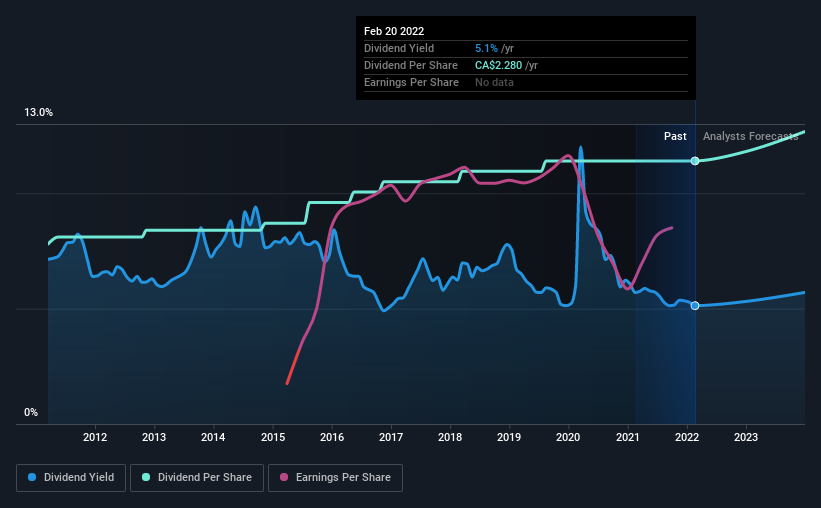Here's Why We're Wary Of Buying Exchange Income's (TSE:EIF) For Its Upcoming Dividend
It looks like Exchange Income Corporation (TSE:EIF) is about to go ex-dividend in the next three days. Typically, the ex-dividend date is one business day before the record date which is the date on which a company determines the shareholders eligible to receive a dividend. The ex-dividend date is important because any transaction on a stock needs to have been settled before the record date in order to be eligible for a dividend. In other words, investors can purchase Exchange Income's shares before the 25th of February in order to be eligible for the dividend, which will be paid on the 15th of March.
The company's upcoming dividend is CA$0.19 a share, following on from the last 12 months, when the company distributed a total of CA$2.28 per share to shareholders. Calculating the last year's worth of payments shows that Exchange Income has a trailing yield of 5.1% on the current share price of CA$44.46. Dividends are a major contributor to investment returns for long term holders, but only if the dividend continues to be paid. We need to see whether the dividend is covered by earnings and if it's growing.
Check out our latest analysis for Exchange Income
Dividends are typically paid from company earnings. If a company pays more in dividends than it earned in profit, then the dividend could be unsustainable. Exchange Income distributed an unsustainably high 141% of its profit as dividends to shareholders last year. Without extenuating circumstances, we'd consider the dividend at risk of a cut. A useful secondary check can be to evaluate whether Exchange Income generated enough free cash flow to afford its dividend. Over the last year, it paid out dividends equivalent to 349% of what it generated in free cash flow, a disturbingly high percentage. It's pretty hard to pay out more than you earn, so we wonder how Exchange Income intends to continue funding this dividend, or if it could be forced to cut the payment.
Cash is slightly more important than profit from a dividend perspective, but given Exchange Income's payouts were not well covered by either earnings or cash flow, we would be concerned about the sustainability of this dividend.
Click here to see the company's payout ratio, plus analyst estimates of its future dividends.

Have Earnings And Dividends Been Growing?
Companies that aren't growing their earnings can still be valuable, but it is even more important to assess the sustainability of the dividend if it looks like the company will struggle to grow. If earnings decline and the company is forced to cut its dividend, investors could watch the value of their investment go up in smoke. With that in mind, we're not enthused to see that Exchange Income's earnings per share have remained effectively flat over the past five years. We'd take that over an earnings decline any day, but in the long run, the best dividend stocks all grow their earnings per share.
We'd also point out that Exchange Income issued a meaningful number of new shares in the past year. Trying to grow the dividend while issuing large amounts of new shares reminds us of the ancient Greek tale of Sisyphus - perpetually pushing a boulder uphill.
Many investors will assess a company's dividend performance by evaluating how much the dividend payments have changed over time. In the past 10 years, Exchange Income has increased its dividend at approximately 3.9% a year on average.
The Bottom Line
Is Exchange Income worth buying for its dividend? It's been unable to generate earnings growth, yet is paying out an uncomfortably high percentage of both its profits (141%) and cash flow (349%) as dividends. It's not an attractive combination from a dividend perspective, and we're inclined to pass on this one for the time being.
With that in mind though, if the poor dividend characteristics of Exchange Income don't faze you, it's worth being mindful of the risks involved with this business. For instance, we've identified 4 warning signs for Exchange Income (1 doesn't sit too well with us) you should be aware of.
Generally, we wouldn't recommend just buying the first dividend stock you see. Here's a curated list of interesting stocks that are strong dividend payers.
Valuation is complex, but we're here to simplify it.
Discover if Exchange Income might be undervalued or overvalued with our detailed analysis, featuring fair value estimates, potential risks, dividends, insider trades, and its financial condition.
Access Free AnalysisHave feedback on this article? Concerned about the content? Get in touch with us directly. Alternatively, email editorial-team (at) simplywallst.com.
This article by Simply Wall St is general in nature. We provide commentary based on historical data and analyst forecasts only using an unbiased methodology and our articles are not intended to be financial advice. It does not constitute a recommendation to buy or sell any stock, and does not take account of your objectives, or your financial situation. We aim to bring you long-term focused analysis driven by fundamental data. Note that our analysis may not factor in the latest price-sensitive company announcements or qualitative material. Simply Wall St has no position in any stocks mentioned.
About TSX:EIF
Exchange Income
Engages in aerospace and aviation services and equipment, and manufacturing businesses worldwide.
Reasonable growth potential with proven track record.
Market Insights
Community Narratives



